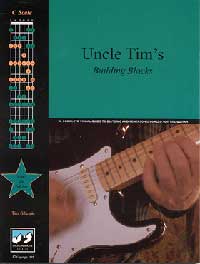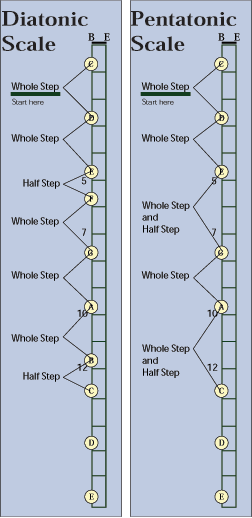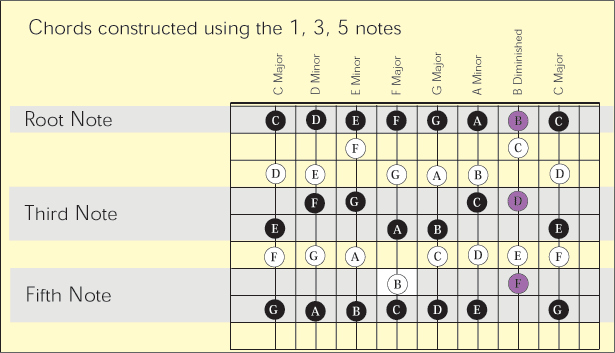

How Does Uncle Tim's Building Blocks Work?
Simply! Here is the concept behind every page of UTBB.
On the fretboard of the guitar is a pattern of notes, once you learn it, you have immediate access to every scale in every part of the fretboard, for every key.
And it is easy to learn the pattern if you look at a picture of it, and music theory is what creates this pattern. This approach makes it super easy! Super easy!
There is nothing like it and nothing can make up for it. For $20, you can put this all to rest right now. Pick up a copy today.
eBooks are delivered instantly!
In order for a scale to exist and have a name, it must somehow be different than all the other scales. If it is not different it is just more of the same and it contributes no additional value. It's a cold, cruel, hard fact of life.
When I think of the task of understanding all the different scale groups and breaking down the chromatic scale so each new scale can be understood, my first reaction is you've got to be kidding. This is the task I faced when compiling them all for my personal libraries. What I found was quite different. These scales are strategically created to solve discreet issues and they are quite interesting to study. This month's newsletter is a condensed look at an upcoming eBook that will take this subject apart completely. Teaching Center members have the opportunity to look at this in detail as they pursue the different eBooks and their descriptions. Knowing all of your options of what scale groups are right for you is very helpful. Otherwise they just all seem to disconnected and detached.
No one I have ever met wants to waste their time. One of the biggest silent objections people have when confronted with learning scales is this. Is this a waste of my time? What am I going to do with this. How will it help me.
Really! Nobody wants to waste their time. So it's natural to question the value of the time and effort necessary to study scales. I am the exact same when it comes to time. If I have any advantage, it is that I will take the time to understand the value of a subject before making up my mind about a new commitment of time.
Anyone who does this with scales will eventually find that they are one of the biggest tools a guitarist has to take control of the instrument. I personally and professionally do not know of any better tools for elevating a person's level of ability than scales. They are the best tool available, hands down.
They are not the answer in themselves. There are other components of a person's bag of skills that must be developed along with scales, but the single biggest and best tool is playing and understanding scales.
I got another example of this the same day I wrote this column. I have a friend that figured out he had a better than usual chance of learning to play a guitar if I helped him. He was right, and his skill are developing nicely. When asked for help, this is what I said.
Play scales, chords and songs, in that order. Practice for at least one hour a day. At first make sure scales occur the majority of your time. This guy is very coachable. He fought me a little at first. But I told him how to proceed and asked him to "trust me". It worked. He countered with something like, can't I just concentrate on learning chords. I said no! Do what I told you.
At first he was not sure, until he thought back to all the letters I showed him from people reporting back on their experience with Uncle Tim's First Year. Then he just went silent and started to pour on the work. He took the leap of faith. He was telling some friends about his progress and that for the first time he is really learning. Now he understands that if you feed your head at the same time you train your fingers, the two will start to work together. He doesn't just play songs by playing chords now. Instead is mixes in small lead lines and pick out interesting notes within the context of the chording and has an altogether deeper and more meaningful experience when he plays. His level of dexterity has increased substantially. He is ecstatic. I know because he won't shut up about it.
It's actually very cool to see the transfer of knowledge, ability and direction to him. The interesting part is we don't even like or play the same songs. So this happened without the synergy of pursuing the same kind of music.
There is no secret to any of this, as he is starting to understand. The real issues is, are you playing meaningful stuff when you practice, and are you developing and then building on your skills?
Once in a while he asks if he is playing scales too much. I usually laugh. At first you cannot overdue this aspect. You are stockpiling skills that will take shape and emerge and startle you when the benefits show up. You will be in a jam session with guitarists of similar ability and surprise yourself when you start to use your new found abilities. You will also quietly realize most of the other players can't take advantage of scales to do this. They never found the reason to practice scales, so they never developed the skills scales bring.
When they do catch the clues, they understand, and then usually the motivation part is in place. Then it becomes an issue of what should they practice. And that is what we are going to talk about today. I intend to keep this discussion introductory in nature and focused on the big picture for a few reasons. The primary reason is we are going to try to begin to understand how and why the different families choose the notes they do and which ones are important to you. Then you can figure out where to pour your very precious time. Remember, nobody wants to waste their time. Nobody.
 As
we have examined in detail before, there are only twelve different notes
on a guitar. No matter where or how you play, you will only find twelve
notes. There are four octaves of these notes but there are only twelve
notes. If you include all twelve notes in a scale, you have created the
chromatic scale.
As
we have examined in detail before, there are only twelve different notes
on a guitar. No matter where or how you play, you will only find twelve
notes. There are four octaves of these notes but there are only twelve
notes. If you include all twelve notes in a scale, you have created the
chromatic scale.
In order to differentiate a scale from the chromatic scale you have to change something. Since the chromatic scale already contains all the notes, you have to eliminate some in order to change the scale. But which ones and why?
Remember the remaining notes must form a tonal center. After all if they don't respond as a tonal center that resolves to some common note, then you just have a collection of arbitrary notes. Some scale groups do fit into this description, but most do form a real tonal center. An example of a group that does not necessarily conform to a tonal based concept are the symmetrical scales. In this group you will find the diminished scale and the whole tone scale. The diminished scale is remarkable for a few reasons. The whole tone scale is less valuable to me. It is just too symmetrical and really does not revolve around a discreet tonal center. That said, there are some symmetrical scales that do interest me. More on that in a moment.
First let's anchor the discussion with a scale we know, the diatonic scale.
The diatonic scales split the twelve chromatic notes into seven positions. They only use seven notes. And the notes are arranged in the same order of whole step, whole step, half step, whole step, whole step, whole step, half step. Here is a diagram so you can review this if you need.
No other scale will have this same spacing. All of the other scale groups will have an altered spacing and that is what determines the characteristics of the scale. Lets take another example and compare it to the diatonic scale. The standard pentatonic scale is the next example.
Pentatonic Scales
 The
pentatonic scale differentiates itself from the diatonic scale by eliminating
the fourth and seventh degrees. In this way, the group of notes still
acts as a tonal center but it has a unique personality.
The
pentatonic scale differentiates itself from the diatonic scale by eliminating
the fourth and seventh degrees. In this way, the group of notes still
acts as a tonal center but it has a unique personality.
Now we have a step and one half space in two places in this scale. The dynamics are changing and so is the sound.
Some of the differences you can see just by talking about, whereas some differences require you to play them to notice them.
If you have been at uncletim.com lately, you may have noticed there are three different pentatonic signatures. Why?
Because there are a few ways to logically alter the scale to create different sounds while maintaining it as a tonal center.
The standard pentatonic scale uses the 1, 2, 3, 5 and 6 degrees of the major scale.
The question becomes how can I alter this scale, still have it conform to tonal center concepts and yet contribute a unique value to the world of scales.
Alternate Pentatonic Forms
Some notes we can change and some we can't. For instance we cannot eliminate the tonic note, so it stays. You have to have a note on which you base the scale. The third degree is usually included because of it's importance in determining the minor and major relationship in chords cointained in the scale. But everything else is fair game. Some choices make more sense that others.
One form of the pentatonic scale uses the 1, 2, 3, 6 and 7 degrees. The seventh degree adds that instability and creates a strong sense of urgency to resolve to tonic, so it makes sense that this is included.
The other common form uses the 1, 3, 4, 5 and 7 degrees. This scale takes the tact that the second degree is not as important and the seventh is. Another big selling point of this scale is the addition of the fourth degree. Notice the standard scale does not include the fourth. In this way the alternate pentatonic scale contributes value by allowing the opportunity to use it.
The third is an important note in scales because in part it determines whether a chord is major or minor. This will affect the harmonization of the chords with the choice of scale. So the third degree usually has a place in the scale.
With these three version of scales, the pentatonic scale covers much more ground and allows for different combinations of notes to be used when assembling the five notes of the scale.
Blues Scales
This is where the pentatonic signature takes a big twist. The Blues scale is very closely related to the pentatonic forms. In fact the blues scales uses the 1, 2, 3, 5 and 6 notes of the diatonic scale, just as the standard pentatonic scale does. However the blues scale is a six note scale and so it adds another note.
It is common to see the blues scale described as the blues pentatonic scale. In fact every instance of the blues pentatonic I have seen is the identical scale as the blues scale. Only the names are different. So it is the same scale.
What makes the blues scale different than the standard pentatonic scale is the addition of one more note. The formula is 1, 2, 2#, 3, 5 and 6 notes. The notes of the 2, 2# and 3 passage dictate three consecutive notes and that is the main engine for creating the blues sound. When you get in to the jazz scales, this 3 consecutive note architecture occurs in all of them. It is the main driving force for the jazzy feel of these scale.

Here is another interesting point about this scale. It is constructed on the minor scale. That means it is constructed according to the rules of the minor key. Usually the examples in this newsletter are in the key of C major. This scale is presented in terms of A minor. You can, however, use this exact scale in the key of C major. In fact the construction rule I mentioned above, 1, 2, 3, 5 and 6 notes are in relation to the major scale. I did this for comparison and simplicity. When the scale is articulated for every key it is presented in terms of the minor keys. As with most scales, it applies to the related minor and major keys.
Look at the passing note (D#) and notice how the addition of this note changes the whole feel of the scale.
In this way the blues scale occupies a unique niche in the overall scheme of scales.
The Diminished Scale
Let me give you one more example, the diminished scale. I choose this scale because it highlights how a scale can be crafted to exploit a specific relationship.

I find this to be a very interesting scale. It is set up to take advantage of minor and diminished relationships in a key. If you look at the notes here, the first thing you should notice is the symmetry in this scale. Look how it is constructed using two notes and then a gap, then the sequence repeats. This is how this scale is constructed and as you can see, it is a symmetrical scale.
Before we examine this scale, let's take a look at how the triad formed from the seventh degree in a major scale creates a diminished triad naturally.

The diminished chord is shown in purple. Notice how it is created by stacking two minor thirds. Well in this scale, every note has a minor triad present. In fact once you achieve a minor triad, you can then stack another one and create a diminished chord. All of this happens without altering the scale whatsoever. This is actually quite ingenious.
Here is an example
From C to D# is a minor third (blue notes). A minor third is two notes, three frets apart. From D# to F# is another minor third. Together they form a C diminished triad. Remember a triad is the simplest chord (three notes). If you try the same construction technique with the C# note it works perfectly. Same for every other note in this scale. Every note can be the root note for a diminished chord. And all the diminished chords will harmonize with this scale, because they are all native to the scale. They are all contained inside the scale.

So one day you may choose to excel at inserting tension into music and you very well may choose this scale for your palette.
All of the exotic scale groups are designed to accommodate one or more specific relationship within the chromatic or key based framework.
When you look at this from a global perspective, you can begin to see it is not only important to be familiar with the diatonic scales but also some additional scales that serve the music you like.
If you play the blues you may want to make sure you are aware of anc can play the Blues scales and the pentatonic group. If you like jazz, then the harmonic, melodic, flat 3rd and jazz scales may be of interest to you. Inside you may very well find the scale exploits the concepts you like the best. In that case you have just gained access to the playground.
There is a world of opportunity to those people that will take the time
to explore. It is one of the ways that additional thinking and experimentation
will help create a skills gap between you and the next person. Thinking
and acting really does pay off.